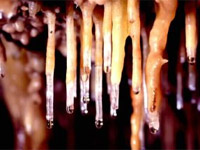
Nature Reserve - Santa Ninfa
Between ups and downs, the traces of the passing of time...
High and white rocks with perpendicular grooves emerge from the green of the valley cultivated with products typical of this corner of Sicily. These are the so-called Karren: furrows moulded by the slow action of the rain.
The area is divided into a pre-reserve area characterized by a karst and chalky landscape, irregular and sculpted by time, with hills and blind valleys. It covers about 150 hectares around the Biviere torrent, a small watercourse flowing from the top of the upland (663 meters above sea level) to the valley where suddenly disappears into the labyrinth of caves and galleries of the Santa Ninfa cave. There the real nature reserve starts.
This cavity stretches horizontally for 1400 meters and is divided into an upper zone that now is dry and a lower zone where there is still a lot of water. The time and the nature, like two highly skilled and patients engravers, drew splendid minerals encrustations of different colors. Inside the cave you can admire magnificent curtains, stalactites, elongated minerals inflorescences and the so-called "cave pearls", some small calcite spheres very rare and wonderful.
The drops of water left hanging, hesitant among the possibility of an anonymous fall on the floor or to trasform themselves into immortal sculptures.
The Reserve belong to the territory of Santa Ninfa and Gibellina. It is characterized by a chalky upland with many underground cavities among whom the St. Ninfa cave is the most important from the speleological and geomorphic point of view.
In the Mount Finestrelle, where the Biviere has its source, there is a Paleochristian necropolis which can be traced back to the period when this area was inhabited by the Elymians. In the southern side there are a series of graves digged in the rocks that looks like many little windows.
When to visit
You can visit the Reserve every day of the year you decide. Legambiente organizes free guided tours throughout all the reserve suject to reservation. Near the boundary of the reserve there is also the Agroforestry Museum where you can find objects many of the old peasant culture and the Finestrelle Wood with an equipped area to enjoy yourself.
How to get there
From motorway A/29 (Palermo - Mazara del Vallo) drive to the junction to go to Salemi and then continue along the trunk road no. 188 towards Santa Ninfa
Administrative body
Legambiente - Regional Sicilian Committee
Via Sant'Anna, 101 - 91029 Santa Ninfa (TP)
Tel/Fax: 0924 62376
Legambiente Offices
Via Agrigento, 67 – 90141 Palermo
Tel: 091 301663 – Fax. 091 626413
For further information: www.legambiente.sicilia.it FLORA & FAUNA
Flora – In the valley, feeding basin of the cave, there are traces of maquis: the scent of the Thymus capitatus and of the Bay, the colours of Wild orchid and of the blooming bushes of the Euphorbia arborea. It is full of different colours: the white fascicles of the Allium subhirsutum, the blue petals of the Nigella arvensis and the yellow ones of the Urospermum dalechampii and the Spanish vetchling that since March starts to show its violet flowers with a deep red vexillum. The dry soil and the plaster hamper the growth of the vegetation. But some species survived the hard natural selection and live on gypsum: the Brassica villosa tinei, a rocky endemic plant of the island, the Sedum gypsicola and the Sedum anopetalum, small perennial succulent plants, and the Toadflax, a perennial plant with yellow trumpet flowers. The Cave – The importance of the Santa Ninfa Cave is increased by the cavernicolous fauna that become adjusted to those wet and dark places. Recently in the cave a new species of arthropod was discovered: the millepede Choneiulus fauneuropae. The valley – In the Biviere valley you can find Hedgehogs, Porcupines, Rabbits, Weasels and Zorros. There are also many Kestrels, medium size birds of prey with big wings, Nightingales and Jays, easily recognizable by their white-blue spots in the wings. In summer the small and gaily-coloured Bee-eater stop there to give birth to their chicks. Among the amphibians it is important to underline the presence of the Discoglossus, a rare species present only in the western Mediterranean.
|

